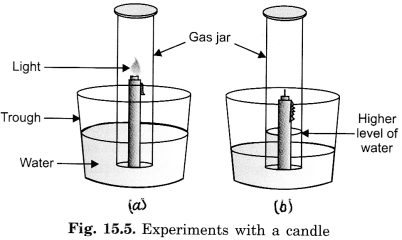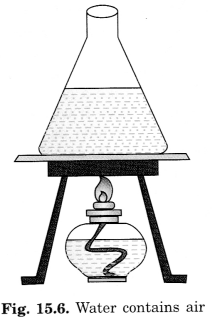NCERT Solutions | Class 6 Science Chapter 15 | Air Around us

CBSE Solutions | Science Class 6
Check the below NCERT Solutions for Class 6 Science Chapter 15 Air Around us Pdf free download. NCERT Solutions Class 6 Science were prepared based on the latest exam pattern. We have Provided Air Around us Class 6 Science NCERT Solutions to help students understand the concept very well.
NCERT | Class 6 Science
| Book: | National Council of Educational Research and Training (NCERT) |
|---|---|
| Board: | Central Board of Secondary Education (CBSE) |
| Class: | 6th |
| Subject: | Science |
| Chapter: | 15 |
| Chapters Name: | Air Around us |
| Medium: | English |
Air Around us | Class 6 Science | NCERT Books Solutions
NCERT TEXTBOOK EXERCISES
NCERT Science book Class 6 Solutions PDF free download, Question 1.
What is the composition of air?ncert class 6 science Chapter 15 question answer, Answer :
Air contains 99% nitrogen and oxygen. The remaining 1% is carbon dioxide and a few other gases, water vapour and dust particles.ncert science class 6 book, Question 2.
Which gas in the atmosphere is essential for respiration?cbse science class 6 solutions, Answer :
Oxygen gas helps in the breakdown of the food to provide energy. This process is called respiration. Thus, oxygen helps in respiration.ncert science class 6 Chapter 15, Question 3.
How will you prove that air supports burning?ncert class 6 science Chapter 15 question answer, Answer :
To show that oxygen supports burning, we have to perform an activity as given below. Fix a candle about 6-8 cm long in the center of a trough or a plate having a raised rim. Now fill the trough or a plate with water to more than half of its height. Light the candle. Next, take a one-liter plastic water bottle and with the help of a sharp knife remove its base. It will serve the purpose of a vessel. Tighten its cap. Then place it over the candle as shown in Fig. 15.5. Observe carefully what happens to the burning candle and the water level. Light the candle again and perform this experiment with a two-liter plastic water bottle. Next, make several holes all over the surface of a smaller plastic bottle with the help of a hot screwdriver or nail. And repeat the experiment with this water bottle.
The candle flickers out after some time in the first two conditions. The candle burns for a shorter period in the smaller bottle. We kept the air limited in the first two conditions. However, in the third experimental condition (b), air was allowed to come and go through the vessel. The candle burns continuously in the bottle having holes. We also see that, if not covered in any closed space, a candle continues burning till it is completely finished. This reflects that burning cannot take place without a continuous supply of air. We can conclude that air is necessary for burning things.
In the first two conditions, there was a rise in water level, while no rising of water would have been observed in the third set up. This indicates that, during burning, some amount of air was used up. The component of air that supports burning is called oxygen.
ncert science class 6 pdf free download, Question 4.
How will you show that air is dissolved in water?cbse science class 6 solutions, Answer :
We take some water in a beaker and heat it slowly on a tripod stand. We see that well before the water begins to boil, tiny bubbles of air are seen on the inside of the beaker. This shows that air is dissolved in water.
ncert science class 6 solutions, Question 5.
Why does a lump of cotton wool shrink in the water?ncert class 6 science Chapter 15 question answer, Answer :
In a cotton lump, a large amount of air is trapped between thin and light cotton fibres making it fluffy. When these fluffy lumps come in contact with water they shrink because the fibres get weight after wetting and the air escapes out from it.ncert science class 6 textbook pdf, Question 6.
The layer of air around the earth is known as ………………………cbse science class 6 solutions, Answer :
Atmosphere.NCERT Solutions for Class 6 Science, Question 7.
The component of air used by green plants to make their food is …………………………….ncert class 6 science Chapter 15 question answer, Answer :
Carbon dioxide.NCERT Solutions for Class 6 Science Chapter 15, Question 8.
List five activities that are possible due to the presence of air.cbse science class 6 solutions, Answer :
Air is very important for living beings. Its various activities are listed below:- It helps in burning.
- It is essential for respiration in living beings.
- It is helpful in the movements of sailing yachts, gliders, parachutes, and air crafts.
- Air current makes the windmill rotate. The windmill is used to draw water from tube wells and to run flour mills. Windmill also generates electricity.
- Birds, bats, and insects fly in the air.
- Air also helps in the dispersal of seeds and pollens of flowers of several plants.
- Compressed air is used in tyres in vehicles.
- Nitrogen present in the air is used on a large scale to manufacture fertilizers.
- Helps in winnowing.
- Helps in hearing sounds.
- CO2 present in air is used by plants in making food (photosynthesis).
- Activities like cloud formation, thundering, etc. occur in air.
science class 6 Chapter 15, Question 9.
How do plants and animals help each other in the exchange of gases in the atmosphere?ncert class 6 science Chapter 15 question answer, Answer :
Animals produce carbon dioxide during respiration and use oxygen whereas plants use carbon dioxide and produce oxygen during photosynthesis. In this way, plants and animals help each other in the exchange of gases in the atmosphere.NCERT Class 6 Science
Class 6 Science Chapters | Science Class 6 Chapter 15
NCERT Solutions for Class 6 Science
NCERT Solutions of Science Class 6 Chapter-wise
Chapter-wise NCERT Solutions for Class 6 Science
-
NCERT Solutions For Class 6 Science Chapter 1 Food Where does it Come From
NCERT Solutions For Class 6 Science Chapter 2 Components of Food
NCERT Solutions For Class 6 Science Chapter 3 Fibre to Fabric
NCERT Solutions For Class 6 Science Chapter 4 Sorting Materials into Groups
NCERT Solutions For Class 6 Science Chapter 5 Separation of Substances
NCERT Solutions For Class 6 Science Chapter 6 Changes Around us
NCERT Solutions For Class 6 Science Chapter 7 Getting to Know Plants
NCERT Solutions For Class 6 Science Chapter 8 Body Movements
NCERT Solutions For Class 6 Science Chapter 9 The Living Organisms and their Surroundings
NCERT Solutions For Class 6 Science Chapter 10 Motion and Measurement of Distances
NCERT Solutions For Class 6 Science Chapter 11 Light, Shadows and Reflections
NCERT Solutions For Class 6 Science Chapter 12 Electricity and Circuits
NCERT Solutions For Class 6 Science Chapter 13 Fun with Magnets
NCERT Solutions For Class 6 Science Chapter 14 Water
NCERT Solutions For Class 6 Science Chapter 15 Air Around us
NCERT Solutions For Class 6 Science Chapter 16 Garbage in, Garbage out
NCERT Solutions for Class 6 to 12
-
NCERT Solutions for Class 6 All Subjects
NCERT Solutions for Class 7 All Subjects
NCERT Solutions for Class 8 All Subjects
NCERT Solutions for Class 9 All Subjects
NCERT Solutions for Class 10 All Subjects
NCERT Solutions for Class 11 All Subjects
NCERT Solutions for Class 12 All Subjects

Post a Comment
इस पेज / वेबसाइट की त्रुटियों / गलतियों को यहाँ दर्ज कीजिये
(Errors/mistakes on this page/website enter here)